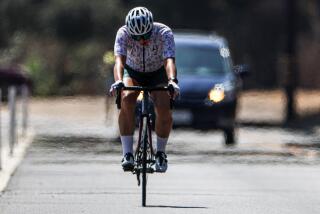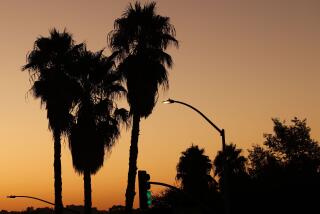No relief from holiday hot spell
Day Five of the year’s longest heat wave sent people fleeing to the beaches this holiday weekend as thousands were left without power in their homes and the promise of relief was still days away.
Late Saturday, power was restored to about 1,600 Eagle Rock households that had been without power since Friday night and to 2,500 in the Los Feliz area that lost power earlier Saturday. Citywide, roughly 5,700 customers lost power Saturday, Los Angeles Department of Water and Power officials said. Roughly 4,500 of Southern California Edison’s 4.8 million customers were without power Friday.
Temperatures are expected to remain in the triple digits throughout the weekend in many areas. Today, temperatures are expected to reach 95 degrees downtown, 102 in Pasadena, 109 in Woodland Hills and 108 in Riverside. Woodland Hills reached 112 degrees Saturday, the high for the Los Angeles Basin, weather officials said.
No real relief will be felt until Tuesday, when night temperatures are expected to drop from the 70s into the 60s, according to Bill Hoffer, a spokesman for the National Weather Service.
“As the temperatures remain high at night it puts a lot more strain on the system,” DWP spokesman Joe Ramallo said. “And you don’t have a chance to cool down the equipment. It’s the equivalent of running a car at 100 mph for 24 hours.”
As temperatures rose, nearly a million people escaped to the beach, where lifeguards reported slightly higher than normal holiday weekend crowds, warm waters, light winds and milder temperatures compared with inland.
“There’s a lot of people at the beach,” said Section Chief Garth Canning of the Los Angeles County Fire Department’s lifeguard division. “It’s postcard perfect. This is the kind of weather people move to California for. It is gorgeous. It’s probably the coolest place in Los Angeles.”
As of 5 p.m., Canning said the beach crowds, which usually start to disperse at that time, seemed to be settling in for the evening and parking areas remained full.
“I’m not watching anyone leave the beach at this moment,” Canning said. “It’s going to be a busy evening.”
Greg Hall, ocean lifeguard specialist in Hermosa Beach, said “it was basically packed” with about 300,000 people. Lifeguards made 56 rescues along South Bay beaches alone, more than normal.
Flash floods, even tornadoes, were also a concern to Southern California officials. The National Weather Service issued a flash flood warning through the evening, as afternoon thunderstorms broke out around the Antelope Valley and in mountains throughout the region.
Meanwhile, police and fire dispatchers in northern Los Angeles County and southern Kern County received several calls around 5 p.m. reporting a funnel cloud over the desert 5 miles to 10 miles north of Lancaster. There were no reports that it made contact with the ground.
At the same time, the National Weather Service issued a tornado warning for east central Kern County, saying that a thunderstorm moving northeast through the area was severe enough to produce one.
Overall, about 3.1 million Southern Californians hit the road this Labor Day weekend, up slightly from last year. Top destinations included San Diego, Las Vegas, the Grand Canyon, Northern California and Mexico, according to the Automobile Club of Southern California. Nationwide, there will be about 34.6 million travelers this weekend.
Airport officials estimate about 825,000 travelers are expected to travel through Los Angeles International Airport from Friday through Monday, a roughly 2% increase from the 810,000 last year.
Energy use was expected to decrease over the weekend with some people out of town, most office buildings closed and temperatures cooling in the northern part of the state. But the DWP was laboring under extreme weekend demand Saturday with 5,344 megawatts. Southern California Edison’s power use approached its weekend peak record with 21,692 megawatts.
The record of 21,982 megawatts was set July 22, 2006.
“Anytime you’re over 18,000 to 19,000 megawatts on a weekend day, [usage] is very high,” said Edison spokesman Steven Conroy. He urged people to conserve power through the weekend.
On Friday, energy-use records were set by Southern California Edison. At 2 p.m. the company broke its peak energy demand record of 22,889 megawatts set July 25, 2006. Energy use peaked in the afternoon at 23,303 megawatts. The DWP also came close to setting a record for power consumption for the second day in a row Friday.
The demand for electricity peaked at 6,107 megawatts, the second-largest daily usage ever, exceeding Thursday’s high of 6,039 megawatts. The DWP record is 6,165 megawatts, set July 24, 2006.
More to Read
Sign up for Essential California
The most important California stories and recommendations in your inbox every morning.
You may occasionally receive promotional content from the Los Angeles Times.










